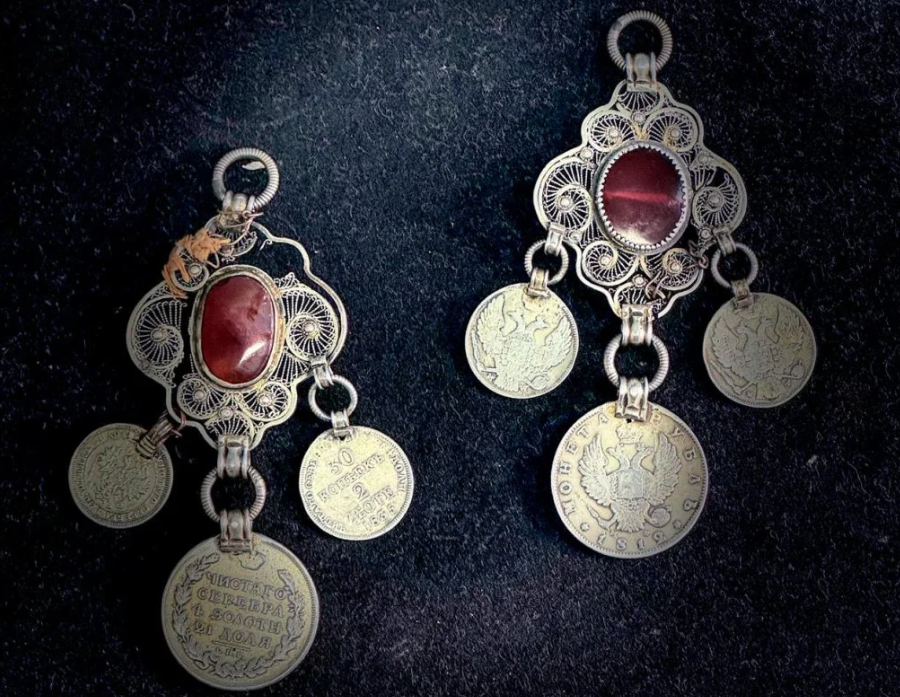ASTANA — Kazakh traditional jewelry, celebrated for its intricate craftsmanship and cultural depth, is experiencing a revival. In Kazakhstan, these ornaments are far more than mere accessories; they embody a rich history, spirituality, and protective symbolism. Spanning centuries, they reveal the social customs and spiritual beliefs of the people who created and wore them.

Antique sholpy with Imperial rubles and Polish zlotys, the Karaganda region. Photo credit: Gulnar Tankayeva / qalam.global
Modern Kazakh women are reclaiming these treasures, blending traditional aesthetics with contemporary fashion. Crafted from precious metals and adorned with semi-precious stones, these ornaments symbolize identity, pride, and cultural continuity.
From birth to death: a lifelong adornment

Jewelry from the State Museum of Art named after Abilkhan Kasteev’s collection. Shekelik, tumar, sholpy. Photo credit: Gulnar Tankayeva / qalam.global
Kazakh women adorned themselves with jewelry throughout their lives, with pieces symbolizing status, age, and heritage. The craft of jewelry-making, or zergerlik in Kazakh, was deeply rooted in traditions passed down through generations. Using techniques such as casting, engraving and stamping, artisans transformed silver and gold into intricate works of art, often complemented by rubies, turquoise, pearls and nacre.
These pieces were not only decorative but also functional and symbolic. Rings, earrings and breast ornaments were designed to reflect social roles or life transitions, such as marriage or motherhood.
For example, the kus muryn (bird’s beak) ring, worn by unmarried girls, symbolized freedom and independence. When a bride married, she brought the ring into her new family as a cherished heirloom. Within a year of her marriage, the bride could receive a visit from her older brother or uncle. If she passed the kus muryn ring to them, it signified her acceptance as a full-fledged member of her husband’s family, marking a significant transition in her life.
Hair jewelry: sacred symbols and elegance
In Kazakh culture, hair holds profound spiritual significance. The belief that hair contained a piece of one’s soul and life force gave rise to numerous traditions and prohibitions such as “never step on hair,” “do not burn fallen hair,” and “avoid haircuts late at night.”
The Kazakh phrase “shash kesken — bas kesken” (to cut off hair is to cut off the head) underscores the reverence for hair. Women meticulously cared for their hair, using traditional remedies such as masks made from airan (a fermented milk product) to maintain hair’s health and beauty.

Shashbau. Late 19th – early 20th century. From the personal collection of jeweler Serikkali Kokenov. Photo credit: Gulnar Tankayeva / qalam.global
While hair was believed to carry a person’s life force, hair jewelry protected against the evil eye and embodied spiritual strength.
Hair jewelry, such as sholpy, shashtenge (hair coin), shashbau (hair cord), and shashkap (hair bag), exemplified the originality of Kazakh design. These ornaments served both aesthetic and protective purposes. Archaeological findings reveal that such decorations date back to the Bronze Age, highlighting their deep historical roots.
Sholpy, attached to braid ends, was thought to encourage growth and prevent hair loss and headaches. Crafted with bells, beads, and gemstones, sholpy created a melodic sound with movement, enhancing a young woman’s charm. A popular saying captures this sentiment, “the crystal chime of laughter echoes the sound of sholpy.”
Another form of hair ornamentation was shashtenge, also known as solkebai. The latter name is believed to derive from the Russian term “tselkovy,” meaning a ruble. As the name suggests, it combines gold or silver coins designed to fasten to braids. The symbolic and decorative use of coins in Kazakh jewelry was observed by German ethnographer Richard Karutz, who remarked, “A silver ruble is more likely to find its way into a woman’s braids than into a chest.”
Shashbau, a ribbon adorned with precious stones, embroidery, and beads, was braided into plaits and celebrated in folk songs as a cherished heirloom.
For practicality, women used shashkap, velvet, or velour covers embroidered with gold threads and beads to protect braids from sunlight and dust.
Attached to braids, all these ornaments often produced a distinctive clinking sound believed to repel evil spirits. The jewelry’s beauty and sound also symbolized prosperity and status. Beyond adornment, hair jewelry had educational value. Girls learned patience and self-control as they walked with these pendants, encouraging them to maintain good posture and graceful gait.
Legends and epics: the role of jewelry in storytelling
Jewelry also played symbolic roles in Kazakh legends and epics. In Kozy Korpesh and Bayan Sulu, the iconic Kazakh love epic, the heroine’s braid adorned with heavy sholpy becomes a tool of justice. This epic, often compared to Romeo and Juliet, tells the story of lovers who face parental opposition but are ultimately separated by tragedy.
However, Bayan Sulu, unlike Shakespeare’s Juliet, takes decisive action. After her fiancé’s murder, she lures the killer, Kodar, into a trap. Pretending to need water from a deep well, she offers her braid, reinforced with heavy sholpy, as a makeshift rope. As Kodar ascends with the water, Bayan Sulu cuts the braid, sending him plunging to his death.
“The Bayan Sulu braid, with heavy ornaments at the ends, freely reached the bottom of the well. Only the faint clinking of the sholpy echoed from the depths, marking Kodar’s fall,” Kazakh writer Satimzhan Sanbaev said, vividly describing this moment in his rendition of the epic.
Jewelry in daily and ritual life
Kazakh jewelry extended beyond personal adornment to include functional and ritual items. Clasps, buttons, and belts often featured intricate designs, while bracelets and rings carried symbolic meanings. For example, the kudagi-zhuzik (mother-in-law’s ring) represented familial unity and goodwill, fostering harmony between families. Earrings, worn from childhood, came in various designs, including crescent-shaped pieces thought to bring good fortune.
Breast ornaments such as the tumarsha served as protective amulets. Often containing prayers or sacred items like owl feathers, these pieces reflected the wearer’s spiritual beliefs and social identity.


